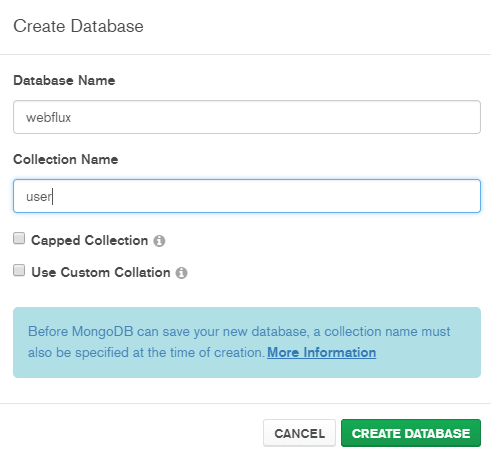在 Spring Boot 2.0 WebFlux编程 一节我们大致了解了WebFlux的用法,这节我们将结合Mongo DB在WebFlux的架构下实现增删改查样例。和 Spring Boot整合Mongo DB 不同的是,我们使用的是Reactive Mongo DB依赖,所有增删改查方法返回值类型为Flux或者Mono。
项目准备
新建一个Spring Boot项目,版本为2.1.3.RELEASE,并引入webflux和reactive mongodb依赖:
1 | <dependency> |
要开启Reactive Mongo DB的相关配置,需要在Spring Boot启动类上添加@EnableReactiveMongoRepositories注解:
1 |
|
接着在配置文件application.yml里配置Mongo DB连接:
1 | spring: |
使用的是webflux数据库,所以需要在Mongo DB里新建一个webflux数据库(并创建user文档/表,以供待会使用):

创建User实体类:
1 | (collection = "user") |
简单增删改查
创建UserDao接口,继承自ReactiveMongoRepository:
1 |
|
和 Spring Boot整合Mongo DB 不同的是,我们继承的是ReactiveMongoRepository而非MongoRepository,它所提供的方法都是响应式的:

在UserService里通过UserDao定义简单增删改查方法:
1 |
|
大致上和 Spring Boot整合Mongo DB 中的UserService差不多,不同的是返回值类型为Flux或者Mono,即它们是响应式非阻塞的方法。
编写RESTfulUserController:
1 |
|
对于返回值为Flux<T>类型的方法,推荐定义两个一样的方法,一个以普通形式返回,一个以Server Sent Event的形式返回。对于修改和删除,如果需要修改和删除的用户不存在,我们返回404。
对于Flux和Mono的操作,在 Spring Boot 2.0 WebFlux编程 一节中已经介绍过了,这里就不再赘述了。
排序与分页
在 Spring Boot整合Mongo DB 一节中,我们通过MongoTemplate实现了排序与分页。与MongoTemplate对于的响应式的对象为ReactiveMongoTemplate,所以我们照葫芦画瓢,仿照MongoTemplate的写法来实现:
1 | /** |
之所以拆分是因为没找到与PageableExecutionUtils类的getPage方法类似的方法,如果是响应式的话,返回值类型应该是Mono<Page<User>>,不懂大家有没别的更好的实现方法?
源码和PostMan测试样例链接:https://github.com/wuyouzhuguli/SpringAll/tree/master/58.Spring-Boot-WebFlux-crud

